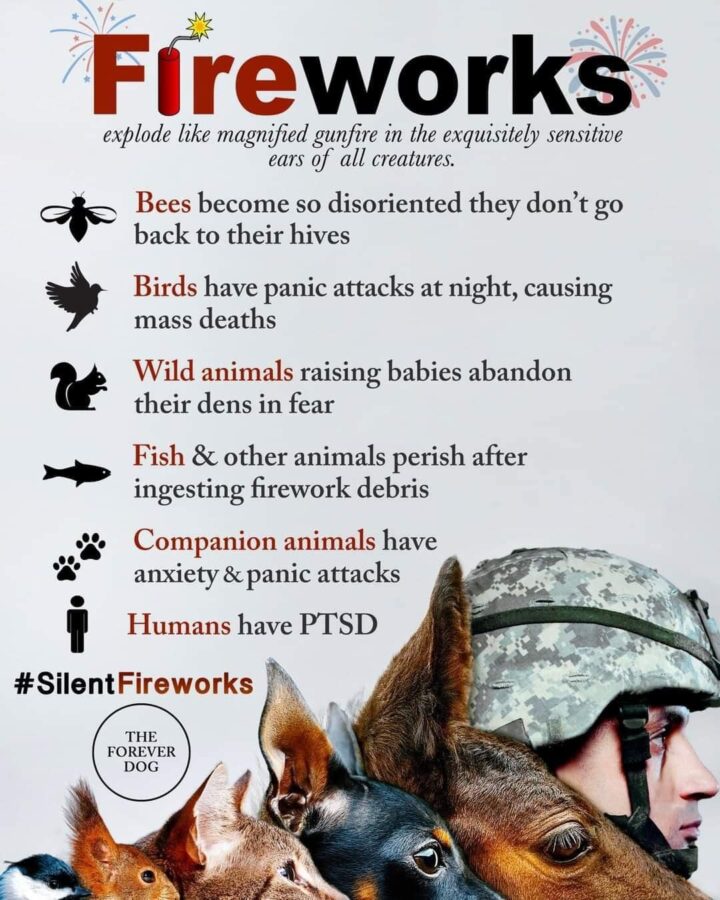
Tuesday is July 4th

News and opinion about wildland fire

The police reported that fireworks is the most likely cause, but it is under investigation
Updated at 5:03 p.m. MDT July 4, 2022
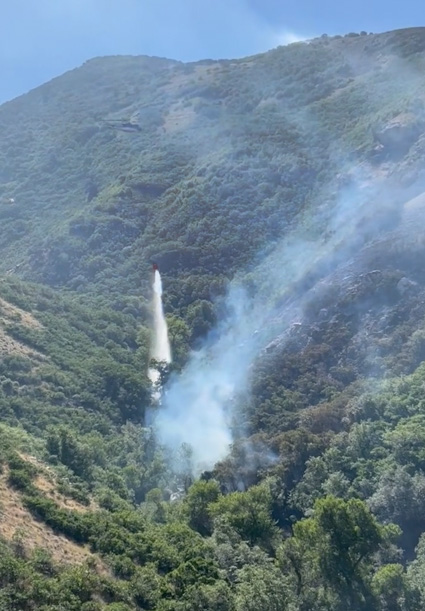
The Deuel Creek Fire in the foothills east of Centerville, Utah was mapped Monday at 128 acres. Firefighting resources assigned include multiple helicopters and 7 engines for a total of 80 personnel; an additional 3 hand crews are en route.
Monday afternoon the fire was less active than it was during the night, but still has potential for growth with the strong winds and low humidity. The fire is between Deuel Creek and Parrish Creek.
12:51 p.m. MDT July 4, 2022
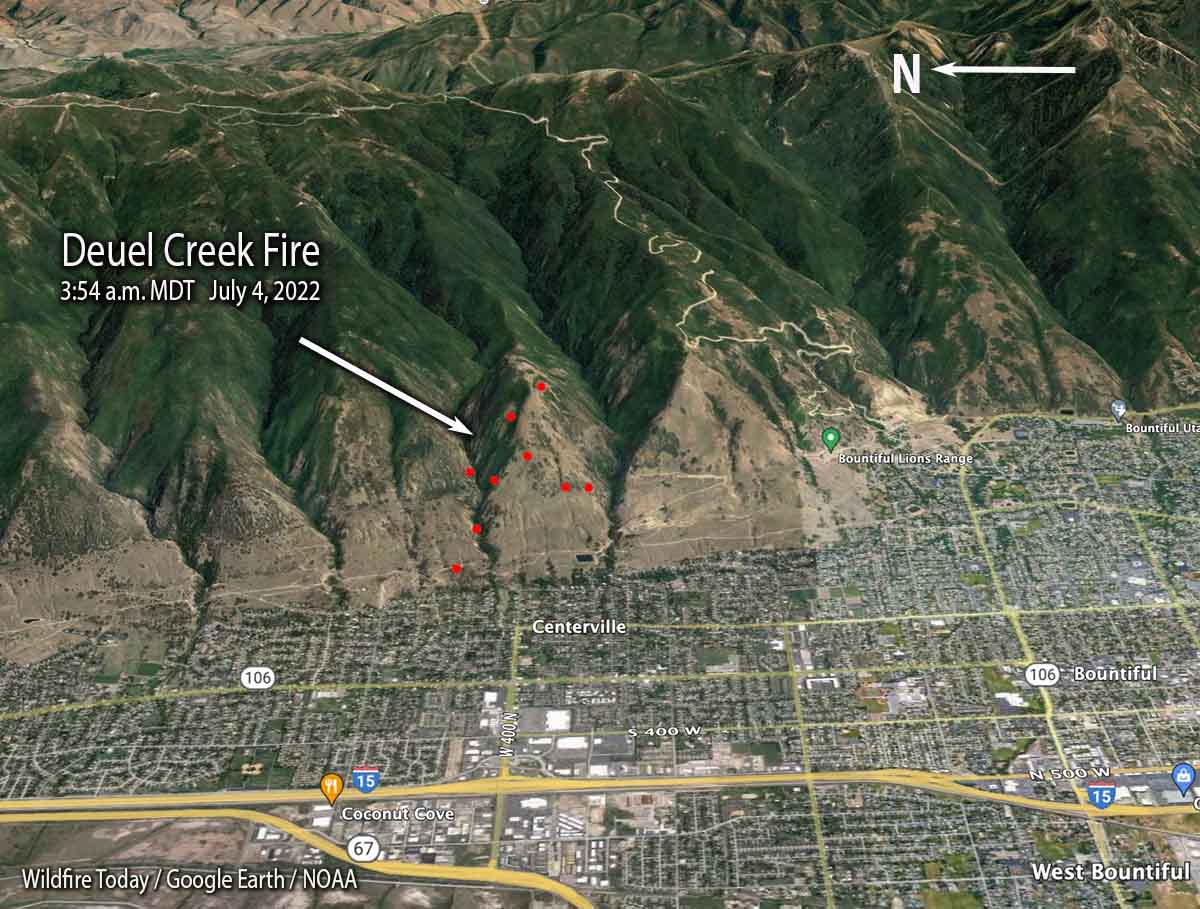
A fire that was reported around midnight Sunday night resulted in the evacuation of about 89 homes on the east side of Centerville, Utah. It started near Center Street and Firebreak Road north of Bountiful. The evacuations were later lifted.
Fire authorities estimate it has burned approximately 100 acres, mostly on a steep slope 10 miles north of Salt Lake City.
“All indications are that this fire was human caused, the most likely source being fireworks,” wrote the Centerville Police Department on Twitter at 5:50 a.m. Monday. “We will be working with fire investigators to determine the cause.”
Much of Western Utah, including the greater Salt Lake City Area, has been under a Red Flag Warning Sunday and Monday for single-digit humidity and strong winds.
A Type 3 Incident Management Team will assume command of the fire Monday morning.
Regarding the tweet below, Spencer J. Cox is the governor of Utah.
This barbecue in Centerville might be a fun one to show up to, since nothing was done about fireworks in the state in the middle of a drought. pic.twitter.com/QHhAHvcJt1
— Kip Hackman (@ndy_Dwyer) July 4, 2022
“Potential risks to the park itself and to the health and safety of employees and visitors associated with the fireworks demonstration continue to be a concern and are still being evaluated as a result of the 2020 event,” said the National Park Service.
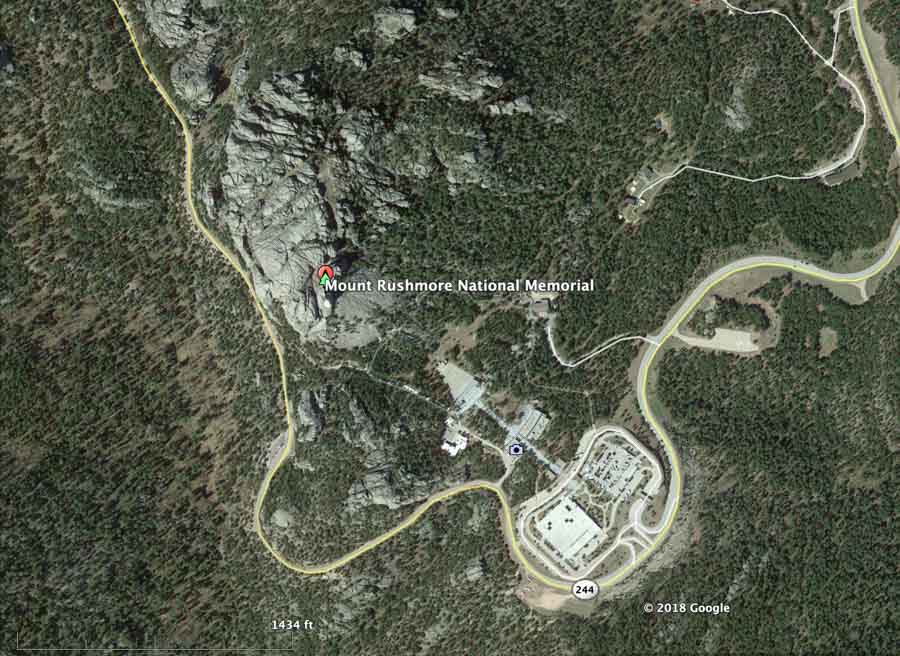
The National Park Service has denied a request from the State of South Dakota to hold a July 4 fireworks display at Mount Rushmore this year.
Last year under pressure from South Dakota Governor Kristi Noem and former President Trump, fireworks were shot from the heads of the four presidents on the sculpture for the first time since 2009. In the interim they had been banned for having started 27 fires, left carcinogens in the water, and the trash dropped by the exploding shells onto the Monument and the forest can never be completely picked up. Fireworks were exploded over the sculpture and the Ponderosa pine forest 11 times between 1998 and 2009.
NPS Regional Director Herbert Frost wrote in a letter to the head of the state’s tourism department, first reported by The Hill Friday, that the NPS is “unable to grant a request to have fireworks at the Memorial.”
“Potential risks to the park itself and to the health and safety of employees and visitors associated with the fireworks demonstration continue to be a concern and are still being evaluated as a result of the 2020 event,” Frost wrote. “In addition, the park’s many tribal partners expressly oppose fireworks at the Memorial.”
“These factors, compiled with the COVID-19 pandemic, do not allow a safe and responsible fireworks display to be held at this site,” he added.
Frost noted that although progress is being made in fighting the pandemic, the situation is still “dynamic” and said it is “only prudent to make plans based on the best available science and public health guidance available today.”
In a joint statement, three members of Congress, Representative Dusty Johnson, Senator John Thune, and Senator Mike Rounds said,
Let’s be clear, this decision is political, not evidence-based. President Biden just said himself that Americans can safely gather by July 4 – what’s changed in a day? Last year millions watched the celebration in awe, and it’s a shame the administration is denying Americans that opportunity this year.
On March 11 in his address to the nation President Biden said,
Because here’s the point, if we do all this, if we do our part, if we do this together, by July the 4th, there’s a good chance you, your families and friends will be able to get together in your backyard or your neighborhood and have a cookout and a barbecue and celebrate Independence Day. That doesn’t mean large events with lots of people together, but it does mean small groups will be able to get together.
According to Johns Hopkins University, of all the U.S. states, as of March 14, 2021 South Dakota has the third-highest number of positive COVID-19 cases per capita, and the sixth-lowest rate of testing per capita. The state has never implemented a mask mandate.
From Forbes, March 13, 2021:
Four days before the fireworks celebration in 2020, a local wildfire update reported that multiple fires had affected nearly 16,000 acres in the Black Hills, near Mount Rushmore. But wildfire experts’ objections to the 2020 celebration went unheeded.
“Burning debris, the burning embers and unexploded shells fall into a ponderosa pine forest and ponderosa pine is extremely flammable,” Bill Gabbert, former fire management officer for Mount Rushmore, told the Argus Leader last year. “Shooting fireworks over a ponderosa pine forest, or any flammable vegetation, is ill advised and should not be done. Period.”
In a break from what had been the standard practice for decades, when the Mine Draw Fire broke out six miles from Mount Rushmore just days before the fireworks were exploded in 2020, Governor Kristi Noem’s office took control of all official information about the fire, shutting down the fire professionals who had always provided information to the public and the media as part of their regular jobs.
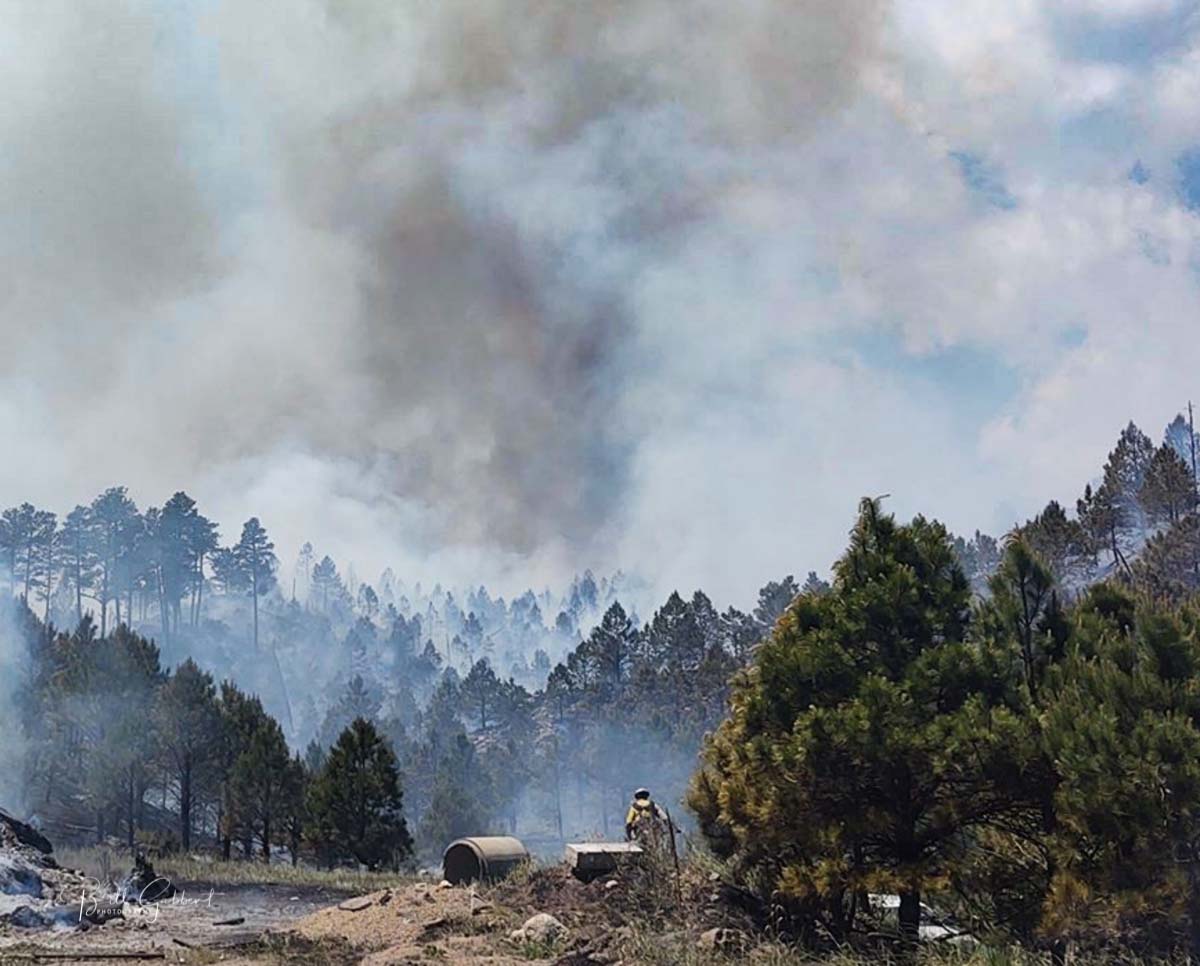
Almost one-fifth inch fell shortly after the fireworks ended

Rain fell shortly after the July 3 fireworks show at Mount Rushmore. The official Remote Area Weather Station at the Memorial recorded 0.17 inch between 10 p.m. and 12 p.m MDT. In less than an hour the relative humidity went from 44% to 86%. The rain was followed 24 hours later with another 0.03 inch at 11 p.m. MDT July 4.
“We had crews monitoring on the mountain last night and they are still working today,” a spokesperson for the Incident Management Team mobilized for the event, Erin Hilligoss-Volkmann, said Saturday afternoon July 4. “There have been no reports of fires as of yet. We are continuing to monitor and will have more information soon. As you’re likely aware, there was a pretty significant rain event following the fireworks event.”
If any fires were started by burning embers from the explosions they likely would have grown very slowly in the sparse fuels remaining two months after the Memorial was treated with a prescribed fire. The rain falling within minutes after the program ended accompanied by very high humidity would have made it difficult for a new fire to grow or avoid extinction.
In addition to the 27 fires started at Mount Rushmore by previous uses of fireworks from 1998 to 2009, many of those concerned about the environment have additional concerns:
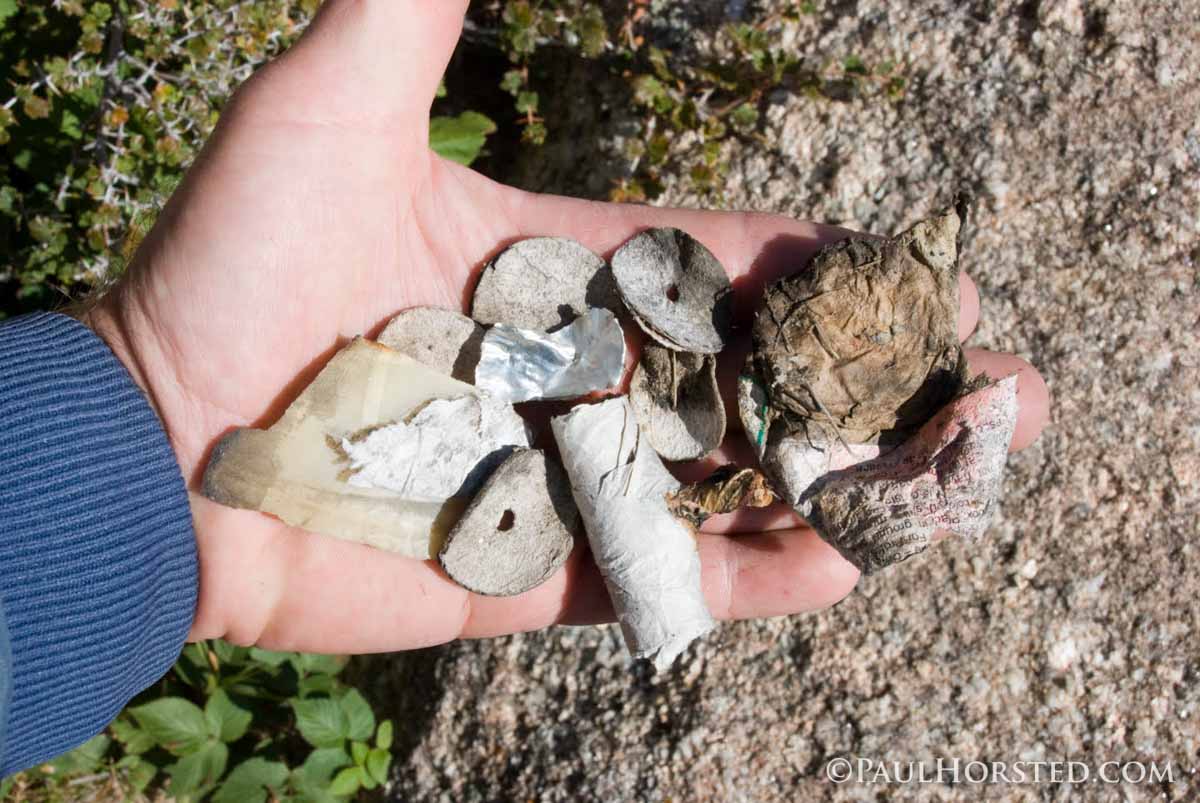
The National Park Service will not disclose their criteria for cancellation due to fire danger
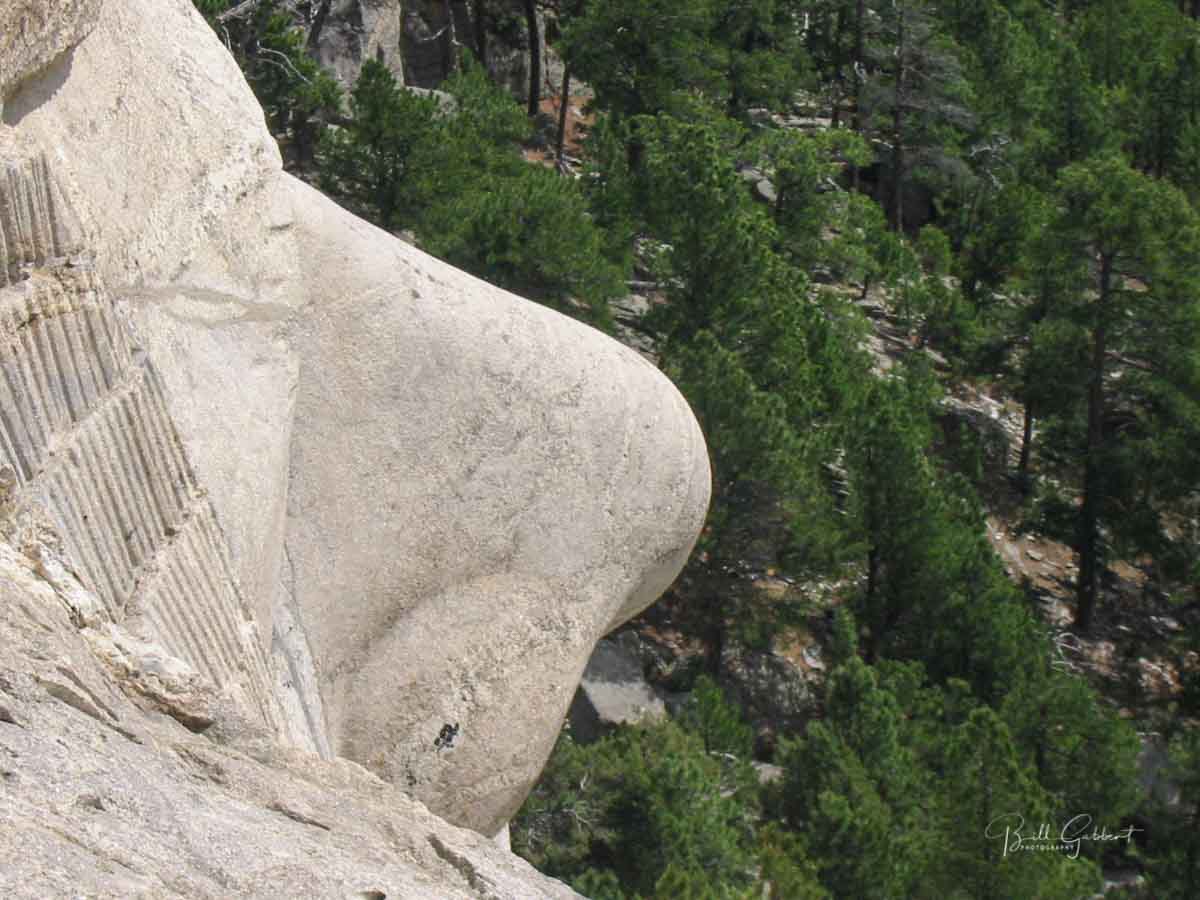
There is a chance that the wildfire danger on July 3 could cause the fireworks planned over Mount Rushmore National Memorial to be cancelled or postponed. But the National Park Service has refused to disclose how they will make their decision.
President Trump and South Dakota Governor Kristi Noem have been advocating for fireworks over the sculpture since 2018. Fireworks were shot at the Memorial 11 times between 1998 and 2009, but were cancelled due to wildfire danger in 2002, 2010, and 2011 and have not been used since.
The President has said, referring to the fireworks,”what can burn? It’s stone.” The sculpture of course is stone, but it is on steep, rugged terrain surrounded by very flammable ponderosa pine trees adjacent to the Black Hills National Forest.
I was the Fire Management Officer for Mount Rushmore and six other National Park Service (NPS) sites from 1998 to 2003 during the first 4 of the 11 years when fireworks were used 1998 through 2009. My job during the events was to organize for and suppress the wildfires using the scores of firefighters we deployed on site.
The Environmental Assessment completed by the National Park Service earlier this year that addressed resuming the fireworks stated that during the 11 years fireworks were used, 20 fires were caused by the fireworks. The Washington Post uncovered a 2017 document in which the National Park Service noted that “a minimum of 27” wildfires were started by the fireworks shows.
My records show that in one two-year period, 2000 to 2001, 17 fires were started — 10 in 2000 and 7 in 2001. I don’t have fire occurrence records for the other nine years of fireworks were used.
In 2000 one of the fires burned through the night, grew to several acres, and required a 20-person crew and a helicopter to bring it under control the following day. There were two injuries; one person had to take time off from work to recover.
Several of the fires were more than 1,000 feet away from the launch site, far beyond the stone referenced by the President.
During the early years of the events I helped develop a Go/No-Go checklist of criteria that had to be acceptable to allow the show to occur. It included items such as obtaining a Spot Weather Forecast from the National Weather Service, wind speed, qualifications of firefighting personnel, and the Probability of Ignition (PI). The PI is the chance that a burning ember or firebrand will cause an ignition when it lands on receptive fuels. The beautiful fiery streaks you see after every explosion of fireworks contain hot embers, some of which after landing on the ground can start a fire.
I still have in my files a letter the NPS Midwest Regional Office sent to the staff at Mount Rushmore after the 17 fires in 2000 and the one that burned into the next day. It directed that in the future the maximum allowable PI be “less than 10 percent.”
I asked the NPS for a copy of the current Go/No-Go checklist and specifically the requirement this year for the PI. My questions were redirected to Erin Hilligoss-Volkmann, the Information Officer on the Incident Management Team that has been assigned to Mount Rushmore to help manage the event. She replied:
The Go/No Go checklist is not publicly available at this time due to security and safety concerns.
Fire condition criteria, such as: the fire preparedness level; burning index; fuels and moisture conditions; wind and weather conditions are part of the assessment. Detailed information about specific trigger points will not be released due to security and safety concerns.
Some current and former NPS employees have concerns about the fireworks.
“I am appalled that fireworks are scheduled for Mt Rushmore, especially considering the high danger of wildfire,” said Valerie Naylor, a retired NPS Superintendent who lives near the memorial. “We determined a decade ago that the wildfire risk, fireworks debris, environmental contamination, and damage to the sculpture were unacceptable. The memorial’s own planning documents reflect that. Now there is the added risk and complexity of operating in a dangerous pandemic. Conducting an event like this is unnecessary and irresponsible and puts park staff and the public at high risk.”
My Opinion
Refusing to disclose the criteria that will determine if it is safe to explode fireworks over a ponderosa pine forest could lead a person to conclude that the National Park Service officials in South Dakota and Washington think they have something to hide. Is it actually a major security issue, or do they just want to conceal facts that could be politically embarrassing? The probability of ignition is not a political issue, it is science. A PI higher than 10 percent could put the public and the natural resources at risk.
The National Park Service needs to put on their big boy pants and be transparent about the fireworks.
The South Dakota Governor’s office should not be overlooked either. In the days leading up to the fireworks a wildfire broke out on state land six miles from Mount Rushmore. For years South Dakota state Incident Commanders and local public information personnel have been the primary distributors of information about developing fires being fought by state personnel. But they were gagged in this case, and the Governor’s office was the only official information source available, presumably because Governor Noem feared the occurrence of a fire near Mount Rushmore could affect the public perception of the wisdom of exploding fireworks over a forest 10 days later into the wildfire season. Even former Governor Bill Janklow, who was very, very hands on when fires were burning, did not attempt to control information about ongoing fires.
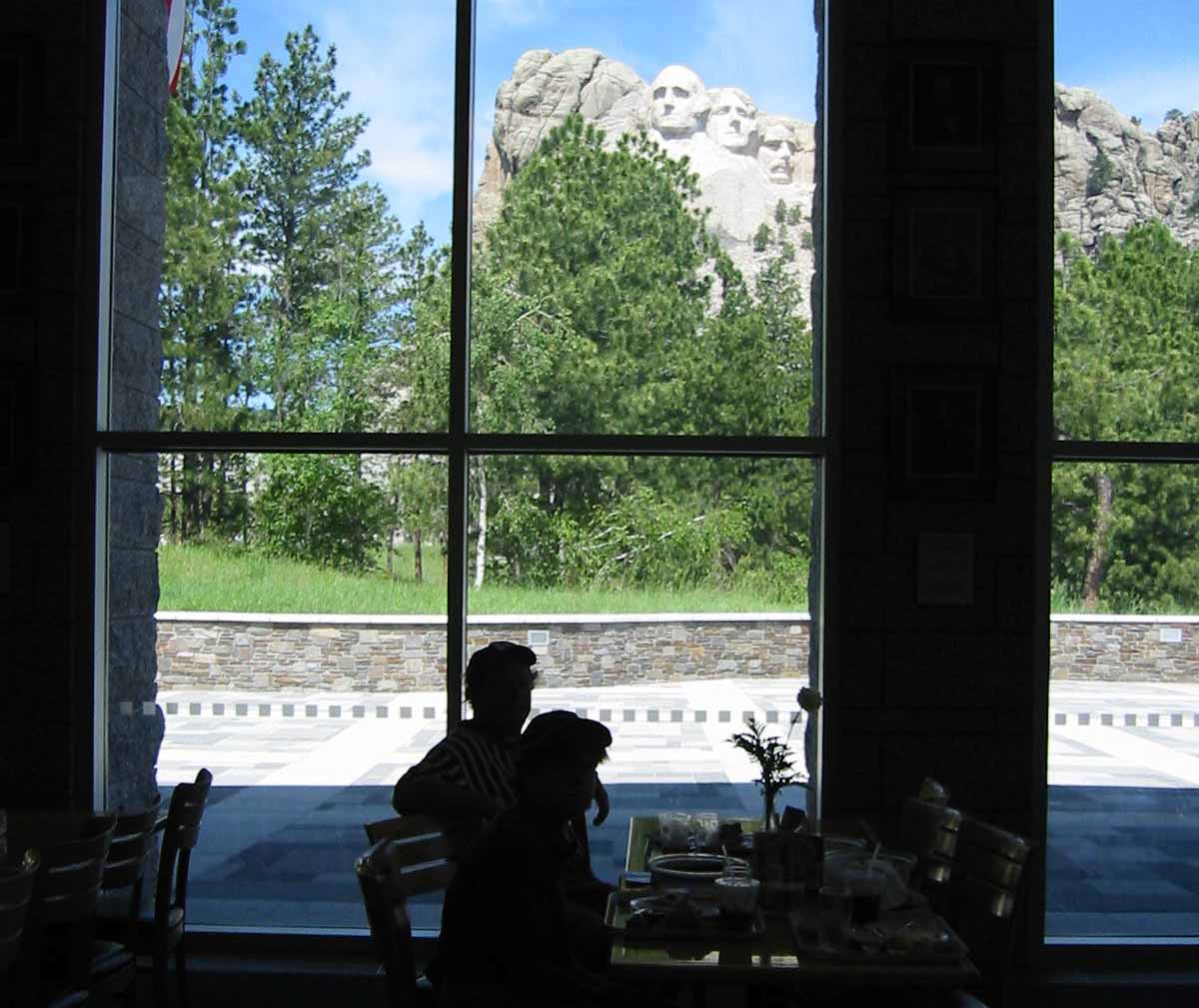
Near Traverse Mountain south of Salt Lake City
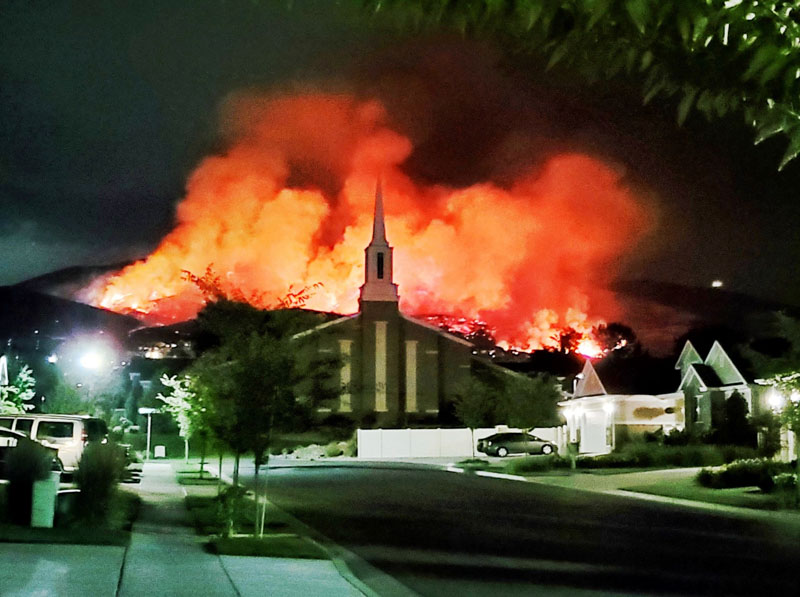
A person using fireworks ignited a wildfire south of Salt Lake City, Utah that led to evacuations north of Lehi.
The Traverse Fire was reported around 12 p.m. Saturday and quickly grew onto Traverse Mountain. Notices from Lehi Community Emergency Response around 3 a.m. Sunday said several areas near the mountain were ordered to evacuate: “Any homes one quarter mile radius from Vialetto Way to Annuvolato Way evacuate, also Autumn Hills Blvd and Spring View Lane.” In Draper city the Maple Hollow neighborhood was ordered to evacuate at about 5 a.m. Sunday.
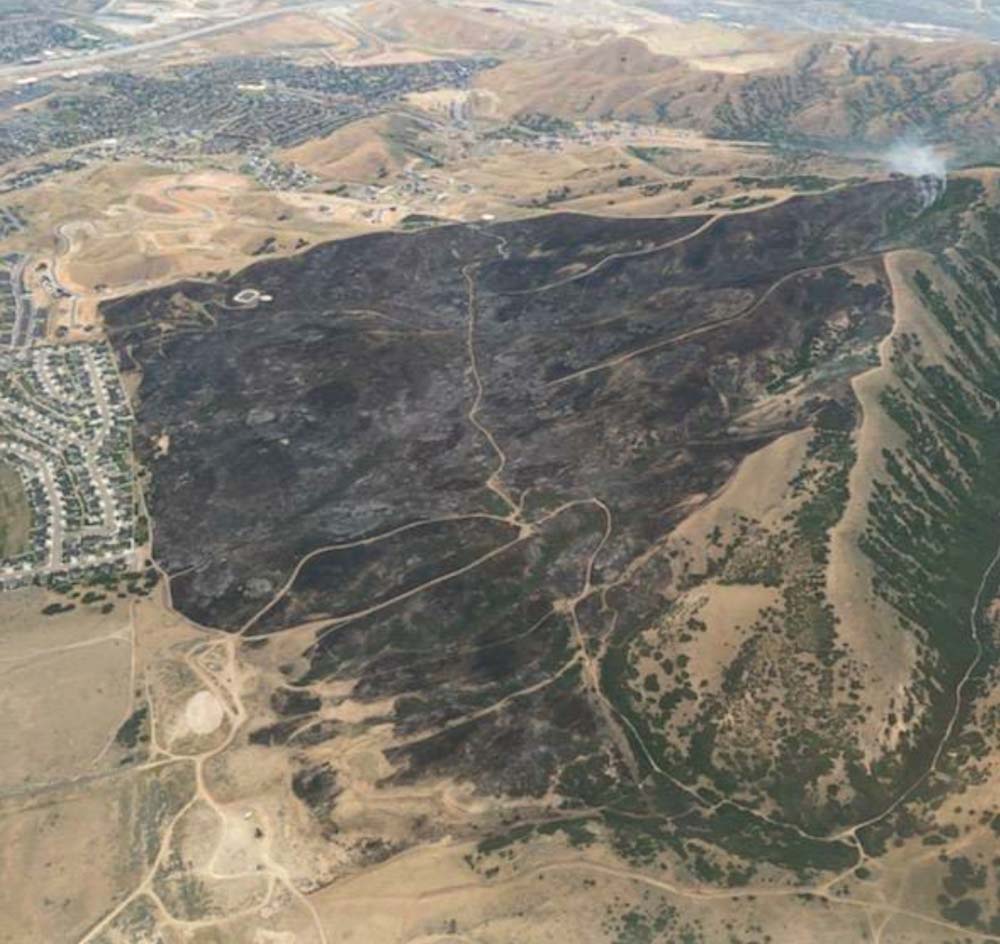
The fire burned up to the back yards of 23 homes in a new subdivision on West Autumn Hills Blvd.
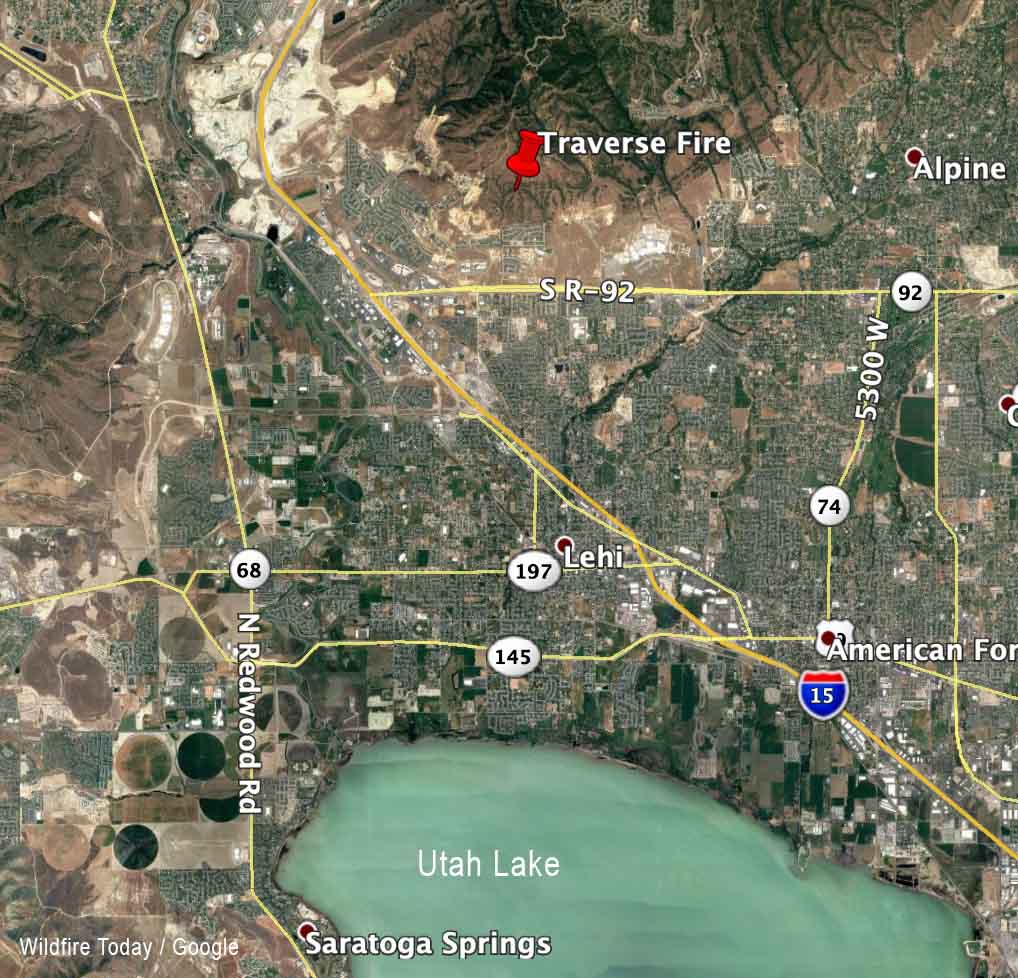
At 11:55 a.m. Sunday Utah Fire Info reported that the Traverse Fire had been mapped at 450 acres. Evacuations were still in effect but “will be reassessed after the anticipated, strong wind event in the forecast has passed.” A current Red Flag Warning for the area is due to low humidity and 20 mph winds gusting over 40 mph through the afternoon. There is a good chance of rain after 3 p.m. Sunday.
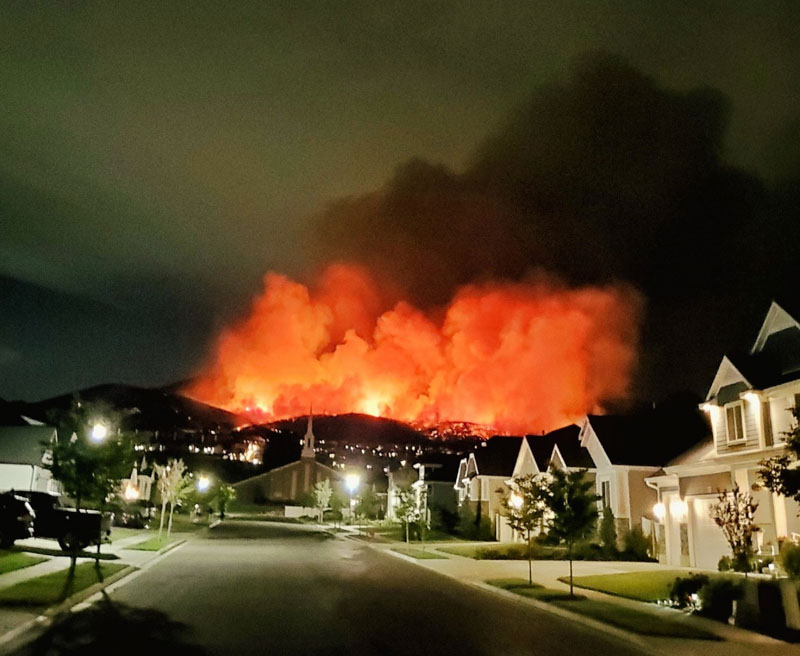
The National Park Service and South Dakota Governor Kristi Noem are planning a fireworks extravaganza over the pine forest at Mount Rushmore National Memorial July 3, 2020.
Thanks and a tip of the hat go out to Rick. Typos or errors, report them HERE.